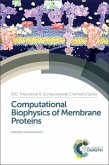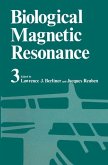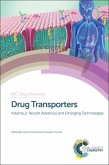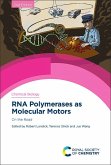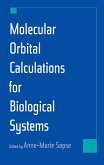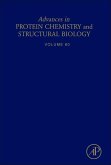Quantum Tunnelling in Enzyme-Catalysed Reactions (eBook, PDF)
Redaktion: Allemann, Rudolf; Scrutton, Nigel S


Alle Infos zum eBook verschenken

Quantum Tunnelling in Enzyme-Catalysed Reactions (eBook, PDF)
Redaktion: Allemann, Rudolf; Scrutton, Nigel S
- Format: PDF
- Merkliste
- Auf die Merkliste
- Bewerten Bewerten
- Teilen
- Produkt teilen
- Produkterinnerung
- Produkterinnerung

Hier können Sie sich einloggen

Bitte loggen Sie sich zunächst in Ihr Kundenkonto ein oder registrieren Sie sich bei bücher.de, um das eBook-Abo tolino select nutzen zu können.
In recent years, there has been an explosion in knowledge and research associated with the field of enzyme catalysis and H-tunneling. Rich in its breath and depth, this introduction to modern theories and methods of study is suitable for experienced researchers those new to the subject. Edited by two leading experts, and bringing together the foremost practitioners in the field, this up-to-date account of a rapidly developing field sits at the interface between biology, chemistry and physics. It covers computational, kinetic and structural analysis of tunnelling and the synergy in combining…mehr
- Geräte: PC
- mit Kopierschutz
- eBook Hilfe
- Größe: 5.46MB
![Computational Biophysics of Membrane Proteins (eBook, PDF) Computational Biophysics of Membrane Proteins (eBook, PDF)]() Computational Biophysics of Membrane Proteins (eBook, PDF)200,95 €
Computational Biophysics of Membrane Proteins (eBook, PDF)200,95 €![Protein Folding, Misfolding and Aggregation (eBook, PDF) Protein Folding, Misfolding and Aggregation (eBook, PDF)]() Protein Folding, Misfolding and Aggregation (eBook, PDF)148,95 €
Protein Folding, Misfolding and Aggregation (eBook, PDF)148,95 €![Biological Magnetic Resonance Volume 3 (eBook, PDF) Biological Magnetic Resonance Volume 3 (eBook, PDF)]() Lawrence J. BerlinerBiological Magnetic Resonance Volume 3 (eBook, PDF)40,95 €
Lawrence J. BerlinerBiological Magnetic Resonance Volume 3 (eBook, PDF)40,95 €![Drug Transporters (eBook, PDF) Drug Transporters (eBook, PDF)]() Drug Transporters (eBook, PDF)178,95 €
Drug Transporters (eBook, PDF)178,95 €![RNA Polymerases as Molecular Motors (eBook, PDF) RNA Polymerases as Molecular Motors (eBook, PDF)]() RNA Polymerases as Molecular Motors (eBook, PDF)176,95 €
RNA Polymerases as Molecular Motors (eBook, PDF)176,95 €![Molecular Orbital Calculations for Biological Systems (eBook, PDF) Molecular Orbital Calculations for Biological Systems (eBook, PDF)]() Molecular Orbital Calculations for Biological Systems (eBook, PDF)24,95 €
Molecular Orbital Calculations for Biological Systems (eBook, PDF)24,95 €![Advances in Protein Chemistry and Structural Biology (eBook, PDF) Advances in Protein Chemistry and Structural Biology (eBook, PDF)]() Advances in Protein Chemistry and Structural Biology (eBook, PDF)108,95 €
Advances in Protein Chemistry and Structural Biology (eBook, PDF)108,95 €-
-
-
Dieser Download kann aus rechtlichen Gründen nur mit Rechnungsadresse in A, D ausgeliefert werden.
- Produktdetails
- Verlag: RSC
- Seitenzahl: 410
- Erscheinungstermin: 27. März 2009
- Englisch
- ISBN-13: 9781847559975
- Artikelnr.: 70093763
- Verlag: RSC
- Seitenzahl: 410
- Erscheinungstermin: 27. März 2009
- Englisch
- ISBN-13: 9781847559975
- Artikelnr.: 70093763
Quantifying the Catalytic Activity of Enzymes
Free Energy Analysis of Enzyme Catalysis
Transition State Stabilisation or Ground State Destabilisation?
Selective Stabilisation of Transition Structures by Enzymes
Enzyme Flexibility and Dynamics. Chapter 2: Introduction to Quantum Behavior - A Primer: Introduction
Classical Mechanics
Quantum Mechanics
Heisenberg Uncertainty Principle
The Schr÷dinger Equation
Electronic Structure Calculations
Born-Oppenheimer Approximation
Hartree-Fock Theory
Basis sets
Zero-point Energy
Density Functional Theory
DFT Calculations of Free Energies of Activation of Enzyme Models
DFT Calculations of Kinetic Isotope Effects
Quantum Mechanics/Molecular Mechanics Methods
Summary and Outlook. Chapter 3: Quantum Catalysis in Enzymes: Introduction
Theory
Variational Transition State Theory
The Transmission Coefficient
One-Dimensional Tunneling
Multidimensional Tunneling
Ensemble Averaging
Examples
Liver Alcohol Dehydrogenase
Dihydrofolate Reductase
Soybean-Lipoxygenase-1 and Methylmalonyl-CoA Mutase
Other Systems and Perspectives
Concluding Remarks. Chapter 4: Selected Theoretical Models and Computational Methods for Enzymatic Tunneling: Introduction
Vibronically Nonadiabatic Reactions: Proton-coupled Electron Transfer
Theory
Application to Lipoxygenase
Predominantly Adiabatic Reactions: Proton and Hydride Transfer
Theory
Application to Dihydrofolate Reductase
Emerging Concepts About Enzyme Catalysis. Chapter 5: Kinetic Isotope Effects from Hybrid Classical and Quantum Path Integral Computations: Introduction
Theoretical Background
Path Integral Quantum Transition State Theory
Centroid Path Integral Simulations
Kinetic Isotope Effects
Sequential Centroid Path Integral and Umbrella Sampling (PI/UM)
The PI-FEP/UM Method
Kleinert's Variational Perturbation (KP) Theory
Potential Energy Surface
Combined QM/MM Potentials
The MOVB Potential
Computational Details
Illustrative Examples
Proton Transfer between Viscosity
Multiple Reactive Configurations and a Place for Single-Molecule Measurements. Chapter 10. Computational Simulations of Tunnelling Reactions in Enzymes
Introduction
Molecular Mechanical Methods
Quantum Mechanical Methods
Combined Quantum Mechanical/Molecular Mechanical Methods
Improving Semiempirical QM Calculations
Calculation of Potential Energy Surfaces and Free Energy Surfaces
Simulation of the H-tunnelling Event
Calculation of H-tunnelling Rates and Kinetic Isotope Effects
Analysing Molecular Dynamics Trajectories
A Case Study: Aromatic Amine Dehydrogenase (AADH)
Preparation of the System
Analysis of the H-tunnelling Step in AADH
Analysis of the Role of Promoting Motions in Driving Tunnelling
Comparison of Short-range Motions in AADH with Long Range Motions in Dihydrofolate Reductase
Summary. Chapter 11. Tunneling Does Not Contribute Significantly to Enzyme Catalysis, But Studying Temperature Dependence of Isotope Effects is Useful
Introduction
Methods
Simulating Temperature Dependence of KIEs in Enzymes
Concluding Remarks. Chapter 12: The Use of X-Ray Crystallography to Study Enzymic H-Tunnelling
Introduction
X-Ray Crystallography: A Brief Overview
Accuracy of X-Ray Diffraction Structures
Dynamic Information from X-Ray Crystallography
Examples of H-tunnelling Systems Studied by Crystallography
Crystallographic Studies of AADH Catalytic Mechanism
Crystallographic Studies of MR
Conclusions. Chapter 13: The Strengths and Weaknesses of Model Reactions for the Assessment of Tunneling in Enzymic Reactions
Model Reactions for Biochemical Processes
Model Reactions Relevant to Enzymic Tunneling
Isotope Effect Temperature Dependences and the Configurational-Search Framework (CSF) for their Interpretation
The Traditionally Dependent Category
The Underdependent Tunneling Category
The Overdependent Tunneling Category
Example 1. Hydride Transfer in a Thermophilic Alcohol Dehydrogenase
The Kirby-Walwyn Intramolecular Model Reaction
The Powell-Bruice Tunneling Model Reaction
Enzymic Tunneling in Alcohol Dehydrogenases
Model Reactions and the Catalytic Power of Alcohol Dehydrogenase
Example 2. Hydrogen-atom Transfer in Methylmalonyl Coenzyme A Mutase (MCM)
Non-enzymic Tunneling in the Finke Model Reactions for MCM
Enzymic Tunneling in MCM
Model Reactions and MCM Catalytic Power
The Roles of Theory in the Comparison of Model and Enzymic Reactions
Model Reactions, Enzymic Accelerations, and Quantum Tunneling. Chapter 14: Long-Distance Electron Tunneling in Proteins: Introduction
Electronic Coupling and Tunneling Pathways
Direct Method
Avoided Crossing
Application of Koopmans' Theorem
Generalized Mulliken-Hush Method
The Propagator Method
Protein Pruning
Tunneling Pathways
The Method of Tunneling Currents
General Relations
Many-Electron Picture
Calculation of Current Density. Hartree-Fock Approximation
Interatomic Tunneling Currents
Many-Electron Aspects
One Tunneling Orbital (OTO) Approximation and Polarization Effects
The Limitation of the SCF Description of Many-Electron Tunneling
Correlation Effects. Polarization Cloud Dynamics. Beyond Hartree-Fock Methods
Quantum Interference Effects. Quantized Vertices
Electron Transfer or Hole Transfer? Exchange Effects
Dynamical Aspects.Chapter 15. Proton-coupled Electron Transfer: The Engine that Drives Radical Transport and Catalysis in Biology
Introduction
PCET Model Systems
Unidirectional PCET Networks
Bidirectional PCET Networks
PCET Biocatalysis
PCET in Enzymes: A Study of Ribonucleotide Reductase
The PCET Pathway in RNR
PCET in the ?2 Subunit of RNR
PCET in ?2 Subunit of RNR: PhotoRNRs
A Model for PCET in RNR
Concluding Remarks.
Quantifying the Catalytic Activity of Enzymes
Free Energy Analysis of Enzyme Catalysis
Transition State Stabilisation or Ground State Destabilisation?
Selective Stabilisation of Transition Structures by Enzymes
Enzyme Flexibility and Dynamics. Chapter 2: Introduction to Quantum Behavior - A Primer: Introduction
Classical Mechanics
Quantum Mechanics
Heisenberg Uncertainty Principle
The Schr÷dinger Equation
Electronic Structure Calculations
Born-Oppenheimer Approximation
Hartree-Fock Theory
Basis sets
Zero-point Energy
Density Functional Theory
DFT Calculations of Free Energies of Activation of Enzyme Models
DFT Calculations of Kinetic Isotope Effects
Quantum Mechanics/Molecular Mechanics Methods
Summary and Outlook. Chapter 3: Quantum Catalysis in Enzymes: Introduction
Theory
Variational Transition State Theory
The Transmission Coefficient
One-Dimensional Tunneling
Multidimensional Tunneling
Ensemble Averaging
Examples
Liver Alcohol Dehydrogenase
Dihydrofolate Reductase
Soybean-Lipoxygenase-1 and Methylmalonyl-CoA Mutase
Other Systems and Perspectives
Concluding Remarks. Chapter 4: Selected Theoretical Models and Computational Methods for Enzymatic Tunneling: Introduction
Vibronically Nonadiabatic Reactions: Proton-coupled Electron Transfer
Theory
Application to Lipoxygenase
Predominantly Adiabatic Reactions: Proton and Hydride Transfer
Theory
Application to Dihydrofolate Reductase
Emerging Concepts About Enzyme Catalysis. Chapter 5: Kinetic Isotope Effects from Hybrid Classical and Quantum Path Integral Computations: Introduction
Theoretical Background
Path Integral Quantum Transition State Theory
Centroid Path Integral Simulations
Kinetic Isotope Effects
Sequential Centroid Path Integral and Umbrella Sampling (PI/UM)
The PI-FEP/UM Method
Kleinert's Variational Perturbation (KP) Theory
Potential Energy Surface
Combined QM/MM Potentials
The MOVB Potential
Computational Details
Illustrative Examples
Proton Transfer between Viscosity
Multiple Reactive Configurations and a Place for Single-Molecule Measurements. Chapter 10. Computational Simulations of Tunnelling Reactions in Enzymes
Introduction
Molecular Mechanical Methods
Quantum Mechanical Methods
Combined Quantum Mechanical/Molecular Mechanical Methods
Improving Semiempirical QM Calculations
Calculation of Potential Energy Surfaces and Free Energy Surfaces
Simulation of the H-tunnelling Event
Calculation of H-tunnelling Rates and Kinetic Isotope Effects
Analysing Molecular Dynamics Trajectories
A Case Study: Aromatic Amine Dehydrogenase (AADH)
Preparation of the System
Analysis of the H-tunnelling Step in AADH
Analysis of the Role of Promoting Motions in Driving Tunnelling
Comparison of Short-range Motions in AADH with Long Range Motions in Dihydrofolate Reductase
Summary. Chapter 11. Tunneling Does Not Contribute Significantly to Enzyme Catalysis, But Studying Temperature Dependence of Isotope Effects is Useful
Introduction
Methods
Simulating Temperature Dependence of KIEs in Enzymes
Concluding Remarks. Chapter 12: The Use of X-Ray Crystallography to Study Enzymic H-Tunnelling
Introduction
X-Ray Crystallography: A Brief Overview
Accuracy of X-Ray Diffraction Structures
Dynamic Information from X-Ray Crystallography
Examples of H-tunnelling Systems Studied by Crystallography
Crystallographic Studies of AADH Catalytic Mechanism
Crystallographic Studies of MR
Conclusions. Chapter 13: The Strengths and Weaknesses of Model Reactions for the Assessment of Tunneling in Enzymic Reactions
Model Reactions for Biochemical Processes
Model Reactions Relevant to Enzymic Tunneling
Isotope Effect Temperature Dependences and the Configurational-Search Framework (CSF) for their Interpretation
The Traditionally Dependent Category
The Underdependent Tunneling Category
The Overdependent Tunneling Category
Example 1. Hydride Transfer in a Thermophilic Alcohol Dehydrogenase
The Kirby-Walwyn Intramolecular Model Reaction
The Powell-Bruice Tunneling Model Reaction
Enzymic Tunneling in Alcohol Dehydrogenases
Model Reactions and the Catalytic Power of Alcohol Dehydrogenase
Example 2. Hydrogen-atom Transfer in Methylmalonyl Coenzyme A Mutase (MCM)
Non-enzymic Tunneling in the Finke Model Reactions for MCM
Enzymic Tunneling in MCM
Model Reactions and MCM Catalytic Power
The Roles of Theory in the Comparison of Model and Enzymic Reactions
Model Reactions, Enzymic Accelerations, and Quantum Tunneling. Chapter 14: Long-Distance Electron Tunneling in Proteins: Introduction
Electronic Coupling and Tunneling Pathways
Direct Method
Avoided Crossing
Application of Koopmans' Theorem
Generalized Mulliken-Hush Method
The Propagator Method
Protein Pruning
Tunneling Pathways
The Method of Tunneling Currents
General Relations
Many-Electron Picture
Calculation of Current Density. Hartree-Fock Approximation
Interatomic Tunneling Currents
Many-Electron Aspects
One Tunneling Orbital (OTO) Approximation and Polarization Effects
The Limitation of the SCF Description of Many-Electron Tunneling
Correlation Effects. Polarization Cloud Dynamics. Beyond Hartree-Fock Methods
Quantum Interference Effects. Quantized Vertices
Electron Transfer or Hole Transfer? Exchange Effects
Dynamical Aspects.Chapter 15. Proton-coupled Electron Transfer: The Engine that Drives Radical Transport and Catalysis in Biology
Introduction
PCET Model Systems
Unidirectional PCET Networks
Bidirectional PCET Networks
PCET Biocatalysis
PCET in Enzymes: A Study of Ribonucleotide Reductase
The PCET Pathway in RNR
PCET in the ?2 Subunit of RNR
PCET in ?2 Subunit of RNR: PhotoRNRs
A Model for PCET in RNR
Concluding Remarks.

